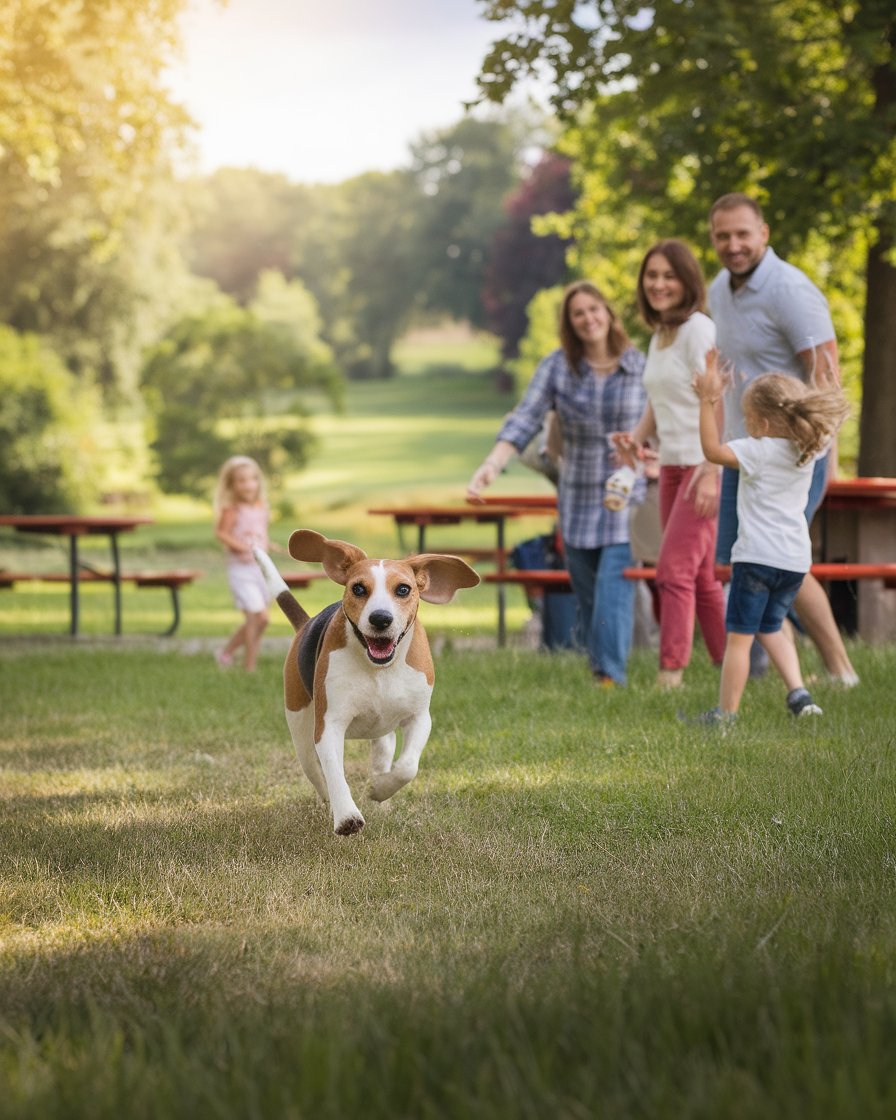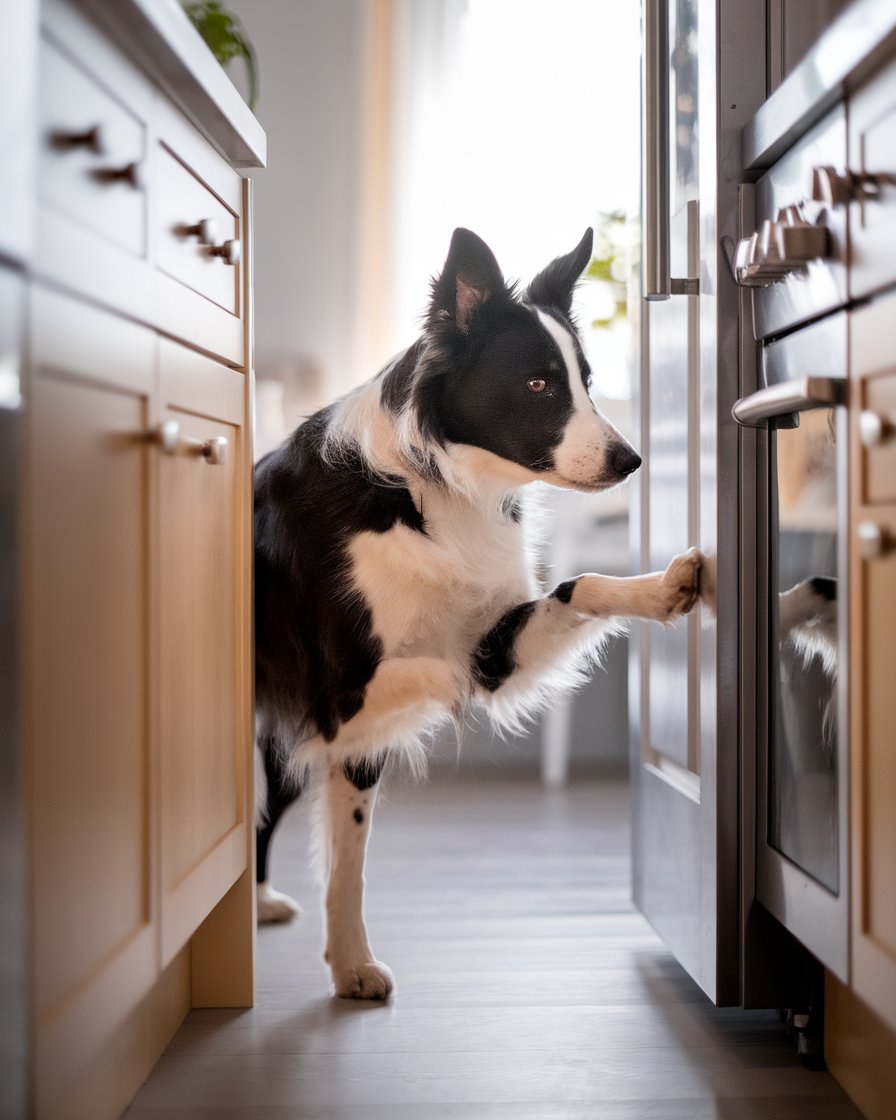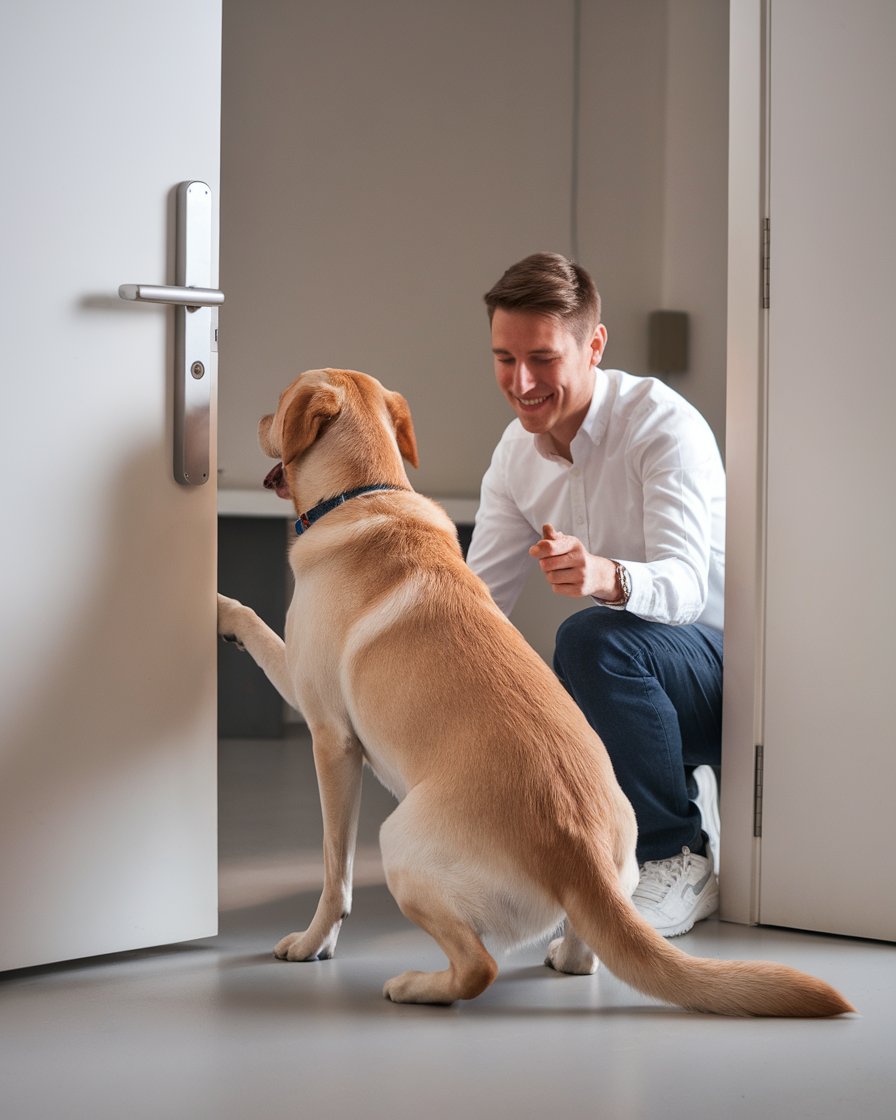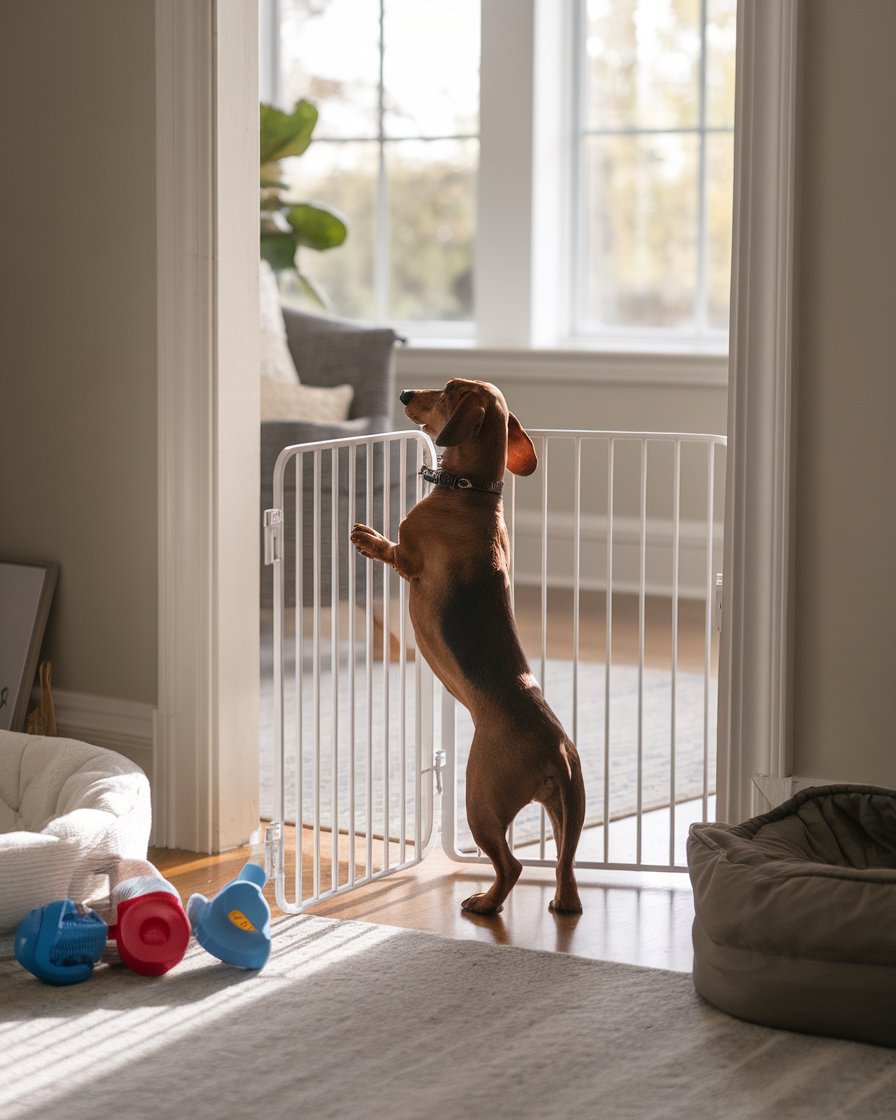Introduction
Dogs are highly intelligent and curious companions, often driven to explore their surroundings. One behavior that stands out is their ability to open doors. Dogs can learn to open doors through observation, showing their intelligence and problem-solving skills. Whether they use their nose or paw, many dogs can mimic the actions of their owners to manipulate door handles and latches. This skill can be helpful but may also lead to unwanted situations if dogs access areas they shouldn’t. Understanding how dogs interact with doors and knowing how to train them is crucial for responsible dog ownership.
Training your dog to open doors requires patience and consistency. Positive reinforcement is one of the most effective methods to teach dogs this skill. Dogs are keen observers, and with the right encouragement, they often learn quickly. Installing child-proof locks or handles that are more difficult for dogs to manipulate can prevent unwanted access. These adjustments ensure that while dogs explore their environment, they do so safely.
Key Takeaways
Dogs can learn to open doors by observing human actions and using their intelligence and problem-solving skills to manipulate handles and latches.
Positive reinforcement techniques like rewards and praise are highly effective in teaching dogs to open doors, making the training process smoother.
Gradual skill development is essential, starting with simple interactions with the door and progressing to more complex tasks like using their paws or nose to unlock or open it.
Dog-proofing doors by installing child-proof locks or more complex handles can prevent dogs from accessing areas they shouldn’t, ensuring their safety.
Providing a safe space for exploration with interactive toys and dog-proofed areas helps satisfy dogs’ natural curiosity while minimizing risky behaviors.
Understanding dogs’ instincts and behavior around doors is critical to training them effectively and keeping both the dog and the household secure.
The Change of Canine Behavior
Dogs have come a long way since their domestication, but they still hold onto many behaviors from their wild ancestors. These behaviors, like forming strong social bonds and showing curiosity, are essential for their survival. For example, dogs often display a pack mentality, staying close to their human family members. This bond reflects their natural instincts. In modern times, their intelligence and desire to explore shine through, especially when you see a dog opening doors. Whether it’s through curiosity or cleverness, a dog can open doors with impressive skill. These behaviors, deeply rooted in their instincts, show how dogs adapt to their environment. It’s fascinating how dogs often learn such skills, and understanding these instincts plays a crucial role in how we train and care for them. In fact, a dog trainer might encourage your dog to refine these behaviors in a way that fits the modern household.
Understanding How Dogs Learn to Open Doors with Their Paw
1. Instinctual Curiosity Drives the Behavior
Dogs are naturally curious creatures, and this curiosity often leads them to explore their environment. When dogs attempt to open doors with their paw, they are following their instincts to investigate and seek new experiences. This behavior is often seen in dogs who want to follow their owners or gain access to a different space, such as a backyard or another room.
2. Observation of Human Actions
Many dogs learn to open doors by watching their owners. Dogs are highly observant and can mimic behaviors, such as seeing a human turn a door handle and replicating the motion with their paw. This shows their ability to understand cause and effect, applying their problem-solving skills to achieve a goal, like opening a door to get outside.
3. Reinforcement of Learned Skills
Through practice and repetition, dogs often refine their door-opening abilities. Dog trainers can encourage this skill by using positive reinforcement, offering treats or praise when a dog successfully interacts with a door. Repetition solidifies the behavior, helping dogs learn to use their paw in specific ways to manipulate a door handle or latch.
4. Adaptation to the Modern Environment
As dogs live in homes with humans, they’ve adapted their natural instincts to fit this environment. Learning to open doors is just one example of how dogs adapt to modern life, using their intelligence to navigate human-designed spaces. Whether it’s pressing on a latch or pushing a door open, dogs often surprise their owners with their ability to figure out these everyday challenges.
Instinctual Behaviors in Domesticated Dogs
Even though dogs have been domesticated, they continue to display some instinctual behaviors. One example is their natural curiosity and desire to explore, which often leads them to use their paws or noses to interact with doors. Many dogs learn to open doors either by mimicking their owners or through experimentation. This behavior showcases their intelligence and adaptability. By understanding and embracing these instincts, owners can ensure that their dogs’ needs are met, whether it’s for exploration or simply navigating the home.
Adaptations for Modern Life
Dogs have adapted remarkably well to living with humans, learning skills like opening doors to move more freely around the house. This ability stems from their sharp problem-solving skills, as they figure out how to use their paws or noses to interact with door handles or knobs. Some dogs are even trained to open doors for their owners, particularly in households with individuals who have mobility challenges. Recognizing these adaptive behaviors allows dog owners to channel their pet’s intelligence in ways that benefit both the dog and the family, ensuring a harmonious living environment.
Observing Dogs in Action
Dogs are constantly engaging with their environment, revealing an array of fascinating behaviors. Whether playing, exploring, or interacting with humans, their actions showcase their intelligence, agility, and adaptability. These moments offer opportunities for owners to observe their dog’s natural instincts and how they adapt to different situations. A common example is when dogs want to open doors, a skill that highlights both their cognitive abilities and their need for exploration. Understanding these behaviors, such as how they manipulate the type of door with their paws or noses, provides insight into their curiosity and problem-solving skills. It’s essential to take measures to stop dogs from opening doors unsafely, especially when they may attempt to open doors with complex mechanisms like doors with round knobs. This awareness can help owners prevent your dog from wandering into risky areas.
Case Study: Dogs Observing and Learning to Open Doors at Kyoto University
A study conducted by Kyoto University in Japan provides an intriguing look at how dogs learn to open doors through observation. The researchers worked with a group of pet dogs and placed them in a controlled environment with two rooms connected by a door. The dogs watched as their owners opened the door by turning the handle and pushing it open. After repeated exposure to this action, several of the dogs began to replicate the behavior, using their paws or noses to turn the handle and push the door open.
The study highlights that dogs can learn through imitation and problem-solving. Dogs who demonstrated this skill showed heightened cognitive abilities, reinforcing the idea that observation and repetition are crucial in a dog’s learning process. This research provides further evidence of how adaptable and intelligent dogs are, particularly when it comes to navigating human-designed spaces and mastering new skills like opening doors.
Analyzing Paw Movement and Grip
Dogs use their paws in a highly coordinated manner, demonstrating a remarkable level of control over their environment. Whether grabbing a toy or attempting to open a door, their grip and paw movements are not random. These actions are shaped by both instinct and experience, allowing dogs to adapt their techniques based on the objects they interact with. For instance, a dog might learn to press a lever or paw at a latch in order to open a door, relying on a mix of natural dexterity and learned behaviors. This adaptability illustrates just how intelligent and observant dogs can be.
Cognitive Processes at Play
Dogs are not only physically adept but also display impressive cognitive abilities. When dogs learn how to open doors, they do so by observing and mimicking human actions, showcasing their problem-solving skills. These cognitive processes are enhanced through repetition and engagement, as dogs continuously refine their approach to overcoming challenges like manipulating a door handle or latch. This ability to understand their environment and adapt to new situations is a clear sign of their intelligence. Owners can encourage their dogs’ cognitive development by introducing new challenges, such as teaching them to open and close doors, reinforcing their natural curiosity and drive to learn.
Training Dogs to Open Doors
Training dogs to open doors can be a rewarding and practical skill that showcases their intelligence and problem-solving abilities. Whether it’s for a service dog or simply to help a household pet gain more independence, teaching a dog to open doors combines patience, consistency, and positive reinforcement. Dogs are naturally curious creatures, and many of them will eagerly explore new challenges like opening doors if given the right motivation. With the right guidance, dogs can learn to use their paws or noses to unlock doors, manipulate handles, or nudge doors open, showcasing their adaptability and innate intelligence.
Positive Reinforcement Techniques
Positive reinforcement is one of the most effective methods to teach dogs how to open doors. By rewarding a dog with treats, praise, or affection each time they successfully engage with the door, trainers can encourage repetition of the behavior. This method helps dogs associate the action with a positive outcome, boosting their enthusiasm for learning. For instance, when a dog nudges a door open using its nose or paw, offering a reward encourages them to continue practicing the skill. Over time, this consistent reinforcement solidifies the behavior, allowing dogs to open doors with ease, confidence, and a sense of achievement.
Gradual Skill Development
Training a dog to open doors doesn’t happen overnight. It requires gradual skill development, starting with simple actions and progressing to more complex tasks. Initially, owners can introduce their dogs to the door, allowing them to explore and get comfortable with its mechanics. From there, the training progresses to encouraging the dog to interact with the door handle or latch, gradually teaching them to nudge it open with their nose or paw. Breaking the process into small, achievable steps helps build the dog’s confidence and competence. With patience and consistent practice, dogs can become adept at opening doors independently, benefiting both the dog and the household.
“Training a dog doesn’t just build their obedience, it unlocks their potential.” – Cesar Millan
Practical Tips for Dog Owners
Being a dog owner comes with many responsibilities, and ensuring the safety and well-being of your pet is a top priority. Dogs are naturally curious and intelligent creatures, often keen to explore their surroundings, which can sometimes lead them into unsafe areas. One of the key skills dogs can develop is learning how to open doors. While this may be impressive, it can also pose risks if they gain access to areas they shouldn’t. To keep your dog safe, it’s essential to understand how to secure your home, encourage responsible behavior, and ensure your dog is well-trained.
Securing Doors to Prevent Unwanted Access
Securing doors is a vital step for any dog owner to prevent their pet from wandering into unsafe areas or even escaping the house. Dogs that know how to open doors can easily manipulate handles, especially if the door is unlocked or equipped with simple latches. Installing child-proof locks or using door handles that are harder for dogs to manipulate can significantly reduce the risk of unwanted access. Regularly checking door mechanisms and ensuring they are properly closed can also prevent accidental openings. These small adjustments can keep your dog safe and give you peace of mind knowing that they aren’t able to open doors unsupervised.
Encouraging Safe Exploration and Play
While securing doors is important, it’s also essential to create an environment where dogs can explore safely. By providing a designated area for your dog to play and roam, you can minimize the temptation for them to open doors in search of new adventures. Dog-proofing areas by removing hazards such as sharp objects, breakable items, or toxic plants is key. Providing interactive toys that challenge their minds and encourage physical activity can also help curb unwanted behaviors, like attempting to open doors. This allows your dog to engage their natural curiosity in a safe, controlled way while still satisfying their need for exploration.
Conclusion
In conclusion, dogs know how to open doors, showing just how smart and adaptable they can be. With a little patience and positive reinforcement, you can teach your dog to open the door using their nose or paw. While this trick is cool and handy, you need to make sure it’s done safely. Consider installing child-proof locks or choosing handles on your doors that are harder for dogs to mess with. This keeps them from getting into places they shouldn’t.
It’s important to remember that dogs are driven by curiosity. They’ll likely attempt to open doors just to explore. By giving them safe areas to play in and fun toys that keep them busy, you can stop your dog from wandering where they shouldn’t. It’s all about balancing their need for adventure with keeping them safe. So, when you teach your dog a new skill, you’re not just helping them learn, you’re also keeping your home safe and sound.











